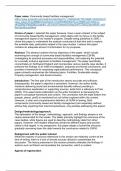Paper name: Community‐based facilities management
https://www.emerald.com/insight/content/doi/10.1108/02632770610666116/full/html?
casa_token=KhuD8BjMOOgAAAAA:cXxWESZM0SQ76xux7SIBkrLlCU0AbLzI-
s4OjGR6CPkMZN0LUvphlhJ_yE1kVUhTcHwhHJiV0ez3irNT3TblYj23wvH9vW_hxR
KtyUldUSsz3icMwA
Choice of paper: I selected this paper because I have a keen interest in the subject
of community-based facility management, which aligns with my focus on the facility
management aspect of my master's program. Despite being published in 2006, I
chose this paper to understand the analysis conducted at that time and to explore
the available data, particularly related to the case studies. I believe this paper
contains an adequate amount of information for my purposes.
Abstract: The abstract outlines the key objectives of the paper, which include
examining the concept of community-based facilities management (CbFM),
investigating its practical processes and responsibilities, and exploring the potential
for a socially inclusive approach to facilities management. The paper specifically
concentrates on Northwest England and incorporates various real-life case studies. It
presents the findings of an initial investigation, proposes provisional conclusions, and
provides a framework for assessing organizational performance. This conceptual
paper primarily emphasizes the following topics: Facilities, Sustainable design,
Property management, and Social inclusion.
Introduction: The first part of the introduction seems accurate and sufficient.
Subsequently, the paper's objective is presented. However, the author briefly
mentions delivering social and environmental benefits without providing a
comprehensive explanation or supporting sources, aside from a reference to Price
(2002). This aspect lacks elaboration as the writer transitions to discussing the
paper's conceptual framework and context. The connection with the triple bottom line
(people, planet, profit) is mentioned but not further explored within the context.
However, a clear and comprehensive definition of CbFM is lacking. Both
components (community-based and facility management) are separately defined
without fully exploring their interconnectedness, only partially addressing this aspect.
Design/methodology/approach:
The delineation of the design, methodology, approach, and findings phases is not
clearly demarcated for the reader. The tables primarily highlight the outcomes of the
case studies, while figures are used to describe methodology data from other
papers. However, the headers effectively divide the different topics and provide
clarity in that regard. In my perspective, this paper adopts a funnel-like structure,
gradually narrowing down the data towards the conclusions related to CbFM.
Realignment with the public interest:
While the majority of sources referenced in this section are relatively current at the
time of writing, there is a lack of diverse sources utilized to substantiate the
discussion. The theory presented in this section primarily reiterates the findings of
authors such as Robert and elucidates the connection, which is evident.
Agents of regeneration
, This section of the paper is deficient in substantial sources that would bolster the
arguments, leading to a one-sided presentation of evidence. Furthermore, there is a
notable absence of sources to substantiate the claims made later in this section.
Although a sentence alludes to a "sustainable difference," it fails to clarify the precise
nature of this sustainable difference: "These are coordinated initiatives and are
intended to support activities which are intended to make a real and sustainable
difference in deprived areas."
CbFM Case Study: New East Manchester
It highlights the presence of a unique catalyst, but the specific outcome resulting
from this catalyst is not mentioned. The paper acknowledges that the regeneration
process is a long-term project, but it does not provide a specific timeframe or clarify
how many years constitute the "long term" in this context. The Commonwealth
Games are noted as a stimulus that has generated a strong and positive momentum
for change. However, the social changes and impacts on the community are not
discussed. The paper simply mentions new developments without providing a clear
definition or explanation of what these developments entail. Moreover, this case
study lacks multiple supporting sources, and the content in the table provided is
general and broad in nature.
The following sentence states the intention to "influence outcomes and create
benefits for these people." However, the specific definition or explanation of what
these benefits entail is absent. The context of sustainability is also not adequately
addressed. There is no prior definition or discussion about sustainability before the
statement that aims "to deliver genuine sustainability of these developments in their
physical impact."
Creating the ripple effect
No specific sources are provided to support the first six terms mentioned above
Figure 3. The concept of the "Ripple effect" is introduced but lacks a clear
explanation both at this point and earlier in the paper. The writer does not offer a
precise definition but uses the concept to elucidate Figure 3. Interestingly, instead of
utilizing the terms "national" and "local," the scope is described as "affected from
local to regional, national, and global." The specific role and meaning of sustainability
in this section are not addressed or defined. Although the paper mentions
"sustainable communities," it fails to provide an explanation of the context and
meaning of this concept. A brief reference is made to Innes and Booher (2000) who
developed indicators for sustainable communities, but no further elaboration is
provided. The relationship between sustainable decisions and performance
indicators is left undefined in this section.
Blended values
This section finally offers a clear definition of sustainability within the context of the
paper. It would be advantageous to include this definition earlier in the paper to
improve understanding. However, the following part lacks a specific source or
reference for the statement attributed to the DTI (Department of Trade and Industry)
regarding their suggestion that organizations...". In one sentence, the context of
benefits is not fully explained; rather, only examples are provided, stating that CSR
yields tangible and measurable business benefits.





